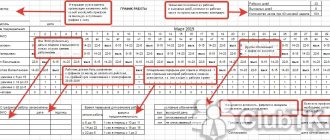Shift mode of operation: main features
Article 101 of the Labor Code of the Russian Federation is responsible for the precise definition of shift work. The schedule involves several main shifts that are used to organize production. This is usually due to the need to ensure a specific working day. Or the opportunity to organize processes more efficiently so that profits and productivity increase.
All workers must complete a specific amount of work in a specified amount of time. The Employment Contract fixes all the important facts related to this area. The schedule also contains detailed information regarding the organization of workdays.
The concept and conditions for drawing up a shift work schedule according to the Labor Code of the Russian Federation
During shift work, the employer draws up shift schedules.
A shift schedule is a table that reflects:
- start and end times of work for each employee;
- shift duration;
- rest periods;
- shift rotation order.
As a rule, organizations have 2 or 3 shifts, less often 4. The Labor Code of the Russian Federation does not contain restrictions on the number of shifts at an enterprise.
The schedule is drawn up taking into account the opinion of the elected body of employees or the trade union. Then the manager issues an order for its approval.
The employee must be familiarized with the work schedule one month before its introduction. He is considered familiar if he has personally signed and dated it on a special sheet, which can be drawn up as an appendix to the employment contract. Also, the familiarization sheet can be filed with the order, and a note about familiarization can be affixed in a special journal. If the employee refuses to sign, a corresponding act is drawn up.
The shift schedule may be approved as an annex to the collective agreement.
An approved and agreed upon shift schedule is mandatory for both the employee and the employer.
What are the advantages of a shift work schedule?
Let us list the obvious advantages of using such a scheme for employees.
| Benefits of shifts | Comments |
| Lack of congestion on the roads due to rush hour | Resolving everyday issues is simplified with the shift option. For example, when days off are scheduled on regular weekdays. |
| Convenient combination with study | A shift schedule is often the best choice for students. They often manage to negotiate with teachers so that they can skip classes from time to time for work. |
| Convenient scheme | Such options are suitable for those who, for some reason, cannot actively travel every day from one place to another. |
| If necessary, employees can change shifts with each other | A shift schedule helps simplify such tasks. Subordinates can agree among themselves; it is not necessary to report every step to their superiors. |
Types of shift work
The legislation offers several implementation schemes:
- 2-shift.
- 3-shift.
- 4-shift.
The main differences between the different options are the combination of work and rest time. It is important that at the end of the specified reporting time, all indicators are brought to current standards, in accordance with the legislation of the Russian Federation. According to Article 104 of the Labor Code of the Russian Federation, you can choose different intervals not exceeding a year.
As for the formation itself, it also relies on several factors:
- Allowable rest interval.
- Limits on the duration of the labor process.
- Total number of employees.
In personnel document flow, rules have been adopted according to which it is necessary to alternate working days with weekends. For example, 2 2 means that there are two working days first, followed by two weekends.
Setting modes involves using one of the following several shifts:
- 2 2. One of the modes that has become especially popular in practice. 12 hours of work followed by rest is the organization method for 90% of cases. Day and night work are also alternated if necessary.
- 4 3. Four consecutive days of work are followed by three days of rest.
- 1 3. Or “in three days.”
- 4 2. 2 2 3. Labor document flow establishes specific numbers. It is then drawn up as a report on the organization of work to date. They allow for shift lengths that fluctuate. The main thing is to remember that it is inadmissible to violate the rules established by law.
Normal working hours and standard time for 2020
What are the normal working hours per week? In accordance with the Labor Code of the Russian Federation, normal working hours cannot exceed 40 hours per week (Article 91 of the Labor Code of the Russian Federation). This is the maximum value. But since the standardization of working hours must take into account the working conditions of workers, their age and other factors, the working time per week may be less than 40 hours. For example, 36 hours a week (Article 92 of the Labor Code of the Russian Federation). With such a length of the working week, the standard working time, for example, in August 2020 is:
- with a 40-hour work week – 184 hours (8 hours x 23 work days);
- with a 36-hour work week – 165.6 hours (7.2 hours x 23 work days).
In 2020, there are only 3 days when working hours must be reduced by an hour, as they immediately precede public holidays: February 23rd, March 8th and November 4th. That is, the total reduction in time is 3 hours. And the total number of working days in a year is 247. As a result, the standard working hours for 2020 is equal to:
- with a 40-hour work week - 1,973 hours (8 hours x 247 work days - 3 hours);
- with a 36-hour work week - 1,775.4 hours (7.2 hours x 247 work days - 3 hours).
You can find out the working hours for other periods of 2020, as well as 2018, from our production calendars for 2017 and 2020, respectively.
Three-shift work schedule
If there are a lot of employees and production is not interrupted, it is important to use work divided into four teams. Workers are divided into exactly the same number of teams. One team rests every day, the remaining three work. The distribution of shifts in most Russian regions is as follows:
- Four days on the night shift, followed by two days off.
- Four days with a day shift, then 1 day off.
- Shift in the evening, 4 working days followed by 1 day off.
The actual hours worked by the crews vary - from 128 to 184 hours. The reporting period is the next few months, for which the preparation is carried out forward. In one month, they are allowed to organize work so that the shortcomings are compensated by overwork in the next segment. It is important to ensure that the weekly working hours are adhered to.
Some enterprises are developing a scheme according to which they are divided into five teams. The breakdown of time spent performing duties affects the final number of days off - 1, 2 or 3.
A ten-day work cycle is most common in enterprises. Each team works from 136 to 152 hours.
Salary
- the size of tariff rates, salaries (official salaries);
- additional payments and allowances of a compensatory nature, including for work in conditions deviating from normal;
- systems of additional payments and bonuses of an incentive nature;
- bonus systems, –
- and are established by collective agreements, agreements, local regulations in accordance with labor legislation and other regulations.
Why is it important? Because the employer needs to decide on the procedure for calculating wages when recording working hours in total.
Since the number of working hours for employees with summarized accounting of working hours for the accounting period (quarter, half-year, year) will differ in different months, it is best to calculate wages in each month based on the number of hours worked.
You may ask: what about the salary? If you pay a certain amount, you don’t need to count anything else. Yes, some employers believe that this is the easiest option. However, the salary when accounting for working time is summarized serves as the basis for calculating the rate per hour of work. This means that the accrued wages will reflect the difference in the number of shifts worked by employees of the same qualifications for the same month.
There are two options for calculating the hourly rate based on salary:
1. The calculation is made taking into account the standard working hours for a given month according to the production calendar. In this case, the hourly tariff rate will be different in different months of the accounting period.
Let’s calculate the hourly tariff rate for June 2020, if the employee’s salary is 30,000 rubles.
According to the production calendar, the standard working hours for a 40-hour work week in July 2020 is 168. Accordingly, the hourly tariff rate in July will be 178.57 rubles/hour (30,000 rubles / 168 hours). In August 2020, with a higher standard number of working hours, the hourly rate will be lower - 163.04 rubles / hour (30,000 rubles / 184 hours).
Restrictions on the use of a shift schedule
Any employment contracts concluded with subordinates record a description of the shift schedule along with its main conditions. In the process of tabulation there is a subsequent clarification of the schemes used.
The Labor Code of the Russian Federation only talks about which categories of employees definitely cannot be involved in the implementation of such schemes:
- Minors.
- Pregnant women.
Certain other categories of persons covered by intersectoral agreements.
Sometimes involvement in such schemes is allowed, but only if there are agreements in writing from the other party. Typically this rule applies to:
- Citizens who care for sick relatives.
- Persons supporting disabled children under 18 years of age.
- Single parents and guardians, adoptive parents of children under 14 years of age.
- Women raising children under 3 years of age.
- Disabled people, regardless of group.
If managers violate legal requirements, serious penalties may be applied to them. An acceptable option is for employees to challenge the legality of such decisions, using the courts as one of the methods.
About the duration of a work shift when using a schedule
They impose a ban on exceeding the weekly norm of 40 hours established by law. The rules are not canceled for enterprises that introduced a shift schedule. A reference to the description of such conditions is required for the Employment Contract. At the legislative level, the exact duration of shifts is regulated only for workers of specific categories.
For example, bus drivers are prohibited from driving for more than 10 hours at a time. But working hours can be increased to 12 hours if the issue is agreed upon with trade union representatives.
The main thing is that all employees have time to eat and take breaks. It takes no more than 120 minutes to rest.
The manager must also take into account an additional 30 minutes of breaks that are not included in the total written rest period. It doesn't matter whether we are talking about day or night shifts. The absence of such conditions in the text of Labor Agreements leads to a violation of the rights and interests of workers.
Standard working hours for 2020 - how to calculate
What is the normal length of working time is a question that is important for both personnel officers and workers. According to the Labor Code of the Russian Federation, the norm is forty hours a week. This is the maximum that an employee can work in a week, both on a five-day and a six-day schedule.
Download documents from the article:
Work time balance XLS file
The standard working day is 8 hours. Based on this figure, schedules are drawn up and the balance of labor time is determined. The monthly norm is easy to calculate based on the weekly norm. It should be taken into account that some categories of workers are supposed to work no more than 36 or 24 hours a week.
The number of working days (weekdays) in 2020 with a five-day work week is 247. The number of weekends and holidays is 118. Thus, the annual standard of working time for 2020 with a 40-hour work week is 1970 hours (40 hours: 5 days. × 247 days – 6 hours).
How we will work and relax in 2020
The Ministry of Labor has determined how we will work and relax in 2020. The New Year holidays will be shortened, but the May holidays will be lengthened. The number of working days and hours in 2020 will be greater, and the number of days that need to be reduced by one hour will also change. Experts from the Personnel Directory magazine have prepared for you production calendars for 2020 for five-day and six-day periods, download them and use them in your work.
With a shift work schedule, the duration of work still cannot exceed 40 hours per week. This is achieved by alternating days of work and rest according to the shift schedule. This procedure also applies to the twelve-hour day. Therefore, the standard working time for 2020 with a shift schedule, regardless of the length of the shift, is also 1970 hours (40 hours: 5 days × 247 days – 6 hours).
There is no standard night time per month established by the Labor Code. However, when working at night, the shift duration must be 1 hour shorter, that is, the employee must work a seven-hour shift. If, due to production needs, it is necessary to work an eight-hour night shift, then the employee must be paid overtime at one and a half times the rate.
Position
Legislation gives managers the right to decide how certain shifts will be organized at the enterprise. The main thing is to comply with the 40-hour work week requirement. The 167-hour standard extends over months.
Minors, pregnant women and disabled people are categories of citizens for whom certain restrictions on the time of one shift are established. Other circumstances allow decisions to be made that are appropriate for a particular situation. The Labor Code imposes virtually no restrictions in this direction.
Employees are replaced at least once every 24 hours when it comes to shifts. The schedule will not change when one team works for 24 hours or more. It is unacceptable to introduce continuous shifts that last a day.
It is permissible to postpone rest days to any convenient time - such periods are designated “floating”.
Duration of work
An employee with a schedule of every three days is at work 24 hours. Does this mean that all 24 hours are working hours? This question often arises when drawing up a work schedule and subsequent timesheets.
Let's turn to Art. 108 of the Labor Code of the Russian Federation, by virtue of which during the working day (shift) the employee must be given a break for rest and food lasting no more than two hours and no less than 30 minutes, which is not included in working hours.
The time for providing such a break and its specific duration are established by internal labor regulations or by agreement between the employee and the employer. For example, during a 24-hour workday, you can set two 45-minute breaks or four 30-minute breaks. There are many options.
However, if, according to the conditions of production (work), it is impossible to provide a break for rest and food, the employer is obliged to provide the employee with the opportunity to rest and eat food during working hours (Article 108 of the Labor Code of the Russian Federation).
Consequently, an employee working on a 24-hour schedule may have 24 hours on his timesheet (when there is no break due to work conditions), or less, for example, 22 hours (when the employee can leave the workplace, and 2 hours of lunch are included in there will be no working hours). As we can see, everything depends on how the break for rest and food is provided and whether the employee can leave the workplace.
For timesheets, it is necessary to take into account not only the duration of daily work, but also the periods that can adjust it. The timesheet reflects the hours actually worked. Their number may differ from the number according to the schedule, since it indicates the planned days and hours of work and rest. During the accounting period, an employee can go on a business trip, get sick, take leave without pay, etc.
Features of the organization of the work process
The specifics of the enterprise influence how specifically the shift schedule is organized. It is important to ensure that the established rules also do not violate the current version of the Labor Code.
Documents have a temporary or permanent basis. That is, strictly for a certain period. The manager himself chooses the exact reporting time:
- Month.
- Quarter.
- Half year.
The manager approves this or that schedule, taking into account the opinion of the trade union representatives. The nature of the main work of subordinates determines the total duration of the shifts, or for its individual stages.
For example, they try to shorten shifts in the case of hazardous industries or in the presence of conditions that can harm health. Or extend it when working in the field of art, theater, and other similar areas.
No less than other categories, shift workers are entitled to annual paid leave, sick leave for at least 10 days, and other rights.
Summarized working time recording
With a “every three days” work schedule, it is difficult to comply with the working hours established by labor legislation, because the employee must be at the workplace for 24 hours. In this case, the company introduces a summarized accounting of working hours (Article 104 of the Labor Code of the Russian Federation) - so that the duration of working hours for the accounting period (month, quarter, etc.) does not exceed the normal number of working hours. The accounting period cannot exceed one year, and for recording the working time of workers in harmful and (or) dangerous working conditions - three months.
The normal number of working hours for the accounting period is determined based on the weekly working hours established for this category of employees. For those working part-time (shift) and (or) part-time week, the normal number of working hours during the accounting period is reduced accordingly. More details on how to calculate the standard working time are stated in the Order of the Ministry of Health and Social Development of the Russian Federation dated August 13, 2009 No. 588n “On approval of the Procedure for calculating the standard working time for certain calendar periods of time (month, quarter, year) depending on the established duration of working time in a week."
For your information
When recording working hours in aggregate, the number of working hours in one day or one week may exceed the permissible norm. However, such excess is compensated by reducing the number of working hours during other days or weeks within the reference period.
Please note that compliance with working hours will have to be checked twice: at the stage of drawing up the schedule and at the end of the accounting period.
The fact is that some periods reduce working hours, for example:
- annual paid holidays;
- periods of temporary disability;
- business trips.
The procedure for introducing summarized recording of working time is established by the internal labor regulations (Part 4 of Article 104 of the Labor Code of the Russian Federation). If such accounting is introduced in the company for the first time, it is necessary to adjust these rules and notify in writing about the change in the working hours of employees who will be affected by the innovations. According to Art. 74 of the Labor Code of the Russian Federation, this must be done at least two months before the introduction of summarized accounting.
When recording working hours in total, a work schedule is required. For our case, when working “in three days,” a schedule is also necessary, and it is best to develop it for the entire accounting period. The schedule should define the start and end time of work, its duration, and rest time. It is advisable that the schedule does not exceed the normal number of working hours.
| Schedule | |||
| Coordinates the work of employees | Informs employees about the beginning and end of working hours and rest periods | Helps to comply with working hours | |
Is it necessary to coordinate the work schedule “in three days” with the trade union and familiarize workers with it with a signature at least a month in advance?
No, and here's why. Indeed, when drawing up work schedules, it is necessary to take into account the opinion of the representative body of workers and the approved schedules are brought to the attention of workers no later than a month in advance. However, such an obligation is established only for shift workers.
According to Art. 103 of the Labor Code of the Russian Federation, shift work is considered to be work in two, three or four shifts when the duration of the production process exceeds the permissible duration of daily work. Accordingly, a distinctive feature of such work is that during the day one worker is replaced by another.
With a schedule of three days every other day, no one replaces the employee during work, which means that she is not shiftable and her schedule does not need to be coordinated with the representative body of employees and comply with the deadlines specified in Art. 103 of the Labor Code of the Russian Federation to familiarize staff with this schedule.
Working hours: basic conditions
The schedules refer to local regulations of enterprises. They are recorded in writing, which must contain a description of the following factors:
- The maximum number of shifts allowed by an enterprise.
- Hours that can be one shift.
- Sequence.
- Weekends and rest hours, between shifts and working days.
- Breaks within one working day.
Be sure to prescribe actions in case the employee next to the one currently performing the work is absent. Do not forget to record the rights and responsibilities of subordinates, the procedure for moving to other schedules, and other similar conditions.
If most of the working time occurs at night, the shift is called a night shift. It is preceded by “evening” time.
16 hour duration for two shifts is maximum. Two 12-hour shifts per day are considered acceptable options.
Employees are prohibited from independently changing the agreement; this cannot be done without approval from the administration.
How to use
Depending on how many people are in a shift, Planimum will evenly distribute weekends and workdays.
For each employee, you can mark the days on which he will not work.
By clicking on the desired day, change its status with the button:
- doesn’t want to work. This request does not change the total number of days the employee must work.
- vacation or sick leave. Reduces the employee's working month.
- must work. The employee must work on this day.
- free. When calculating the plan, this day can become either a working day or a weekend. Initially, all days have this status.
The plan can be recalculated several times.
For anonymous users, each plan option will have its own link (appears below the editor). The plan for it cannot be edited.
Registered users have a permanent link to the plan. The author can edit it at any time.
You can try it right here. But after you close the page, the plan will be available for reading only (via a separate link). If you want to edit it in the future and make new plans based on it, register.
Overtime cases
Any overtime worked will result in double rates being applied. The first two hours of processing require a factor of one and a half. For subsequent hours the bet is doubled.
An hourly reduction in working hours always accompanies the pre-holiday days. If production cannot be stopped even on holidays and weekends, an hour is then added to paid vacations. Or for such duties they receive monetary compensation, also with double tariffs.
Development of a schedule and its implementation
The employer must go through several stages for the document to become legal and gain force:
- Issuance of the corresponding order, in any form. The specific positions to which the new regime is applied are indicated separately. It is impossible to do without descriptions of deadlines and specific actions.
- The document will not be legal without a condition for introducing the scheme at the enterprise.
- Drawing up a specific option for certain jobs. Sometimes it is necessary to send a document to a representative body of workers in order to take into account the opinion. After approval, management can begin to issue orders in accordance with all the rules.
- The employment contract also describes the exact conditions for the applicable regime.
The Labor Code of the Russian Federation allows for a situation where shift schedules serve as additional annexes to labor agreements. If there are no such regulations at the enterprise, it is allowed to develop a document separately and put it into effect accordingly.
At least 1 month before the introduction of the regime in practice - this is how long before the information on changes is brought to the attention of employees. Dates of approval and the exact time of review of orders and other documents are information that requires special attention. Timely notification is one of the most important nuances on which compliance with the rights and interests of employees and further legal proceedings depend.
The employer chooses the way in which employees receive information:
- Mailing of letters.
- Information stands with posted information.
- Issuing advertisements against receipts.
How to print graphs?
You can export the graph to DOC or PDF (with your favorite picture as the background if desired), and then print the finished document. This can be done by clicking the corresponding icon at the top right of the page.
Our editor received a letter with a question about working on a “every three days” schedule. A reader asked how long a shift should be - after all, you can’t work 24 hours without lunch? Indeed, some organizations require workers who will work around the clock - security guards, salespeople, etc. And of course, it is necessary to properly organize the work process for them so that the norms of labor legislation are observed. Can a shift last 24 hours or does it need to deduct lunch time? Which accounting period is best for this mode of operation? Do I need to draw up schedules and introduce them to them a month before the introduction? What is the peculiarity of remuneration when working “in three days”? You will get answers to these and some other questions by reading the article.









